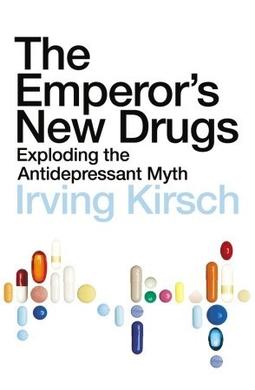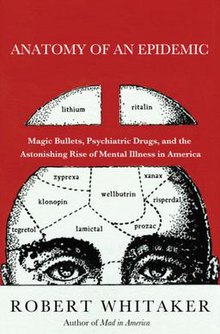
Antipsychotics, previously known as neuroleptics and major tranquilizers, are a class of psychotropic medication primarily used to manage psychosis, principally in schizophrenia but also in a range of other psychotic disorders. They are also the mainstay, together with mood stabilizers, in the treatment of bipolar disorder. Moreover, they are also used as adjuncts in the treatment of treatment-resistant major depressive disorder.
A psychiatric or psychotropic medication is a psychoactive drug taken to exert an effect on the chemical makeup of the brain and nervous system. Thus, these medications are used to treat mental illnesses. These medications are typically made of synthetic chemical compounds and are usually prescribed in psychiatric settings, potentially involuntarily during commitment. Since the mid-20th century, such medications have been leading treatments for a broad range of mental disorders and have decreased the need for long-term hospitalization, thereby lowering the cost of mental health care. The recidivism or rehospitalization of the mentally ill is at a high rate in many countries, and the reasons for the relapses are under research.
The American Psychiatric Association (APA) is the main professional organization of psychiatrists and trainee psychiatrists in the United States, and the largest psychiatric organization in the world. It has more than 38,000 members who are involved in psychiatric practice, research, and academia representing a diverse population of patients in more than 100 countries. The association publishes various journals and pamphlets, as well as the Diagnostic and Statistical Manual of Mental Disorders (DSM). The DSM codifies psychiatric conditions and is used mostly in the United States as a guide for diagnosing mental disorders.

The Rosenhan experiment or Thud experiment was an experiment conducted to determine the validity of psychiatric diagnosis. Participants submitted themselves for evaluation at various psychiatric institutions and feigned hallucinations in order to be accepted, but acted normally from then onward. Each was diagnosed with psychiatric disorders and were given antipsychotic medication. The study was conducted by psychologist David Rosenhan, a Stanford University professor, and published by the journal Science in 1973 under the title "On Being Sane in Insane Places".
Biological psychiatry or biopsychiatry is an approach to psychiatry that aims to understand mental disorder in terms of the biological function of the nervous system. It is interdisciplinary in its approach and draws on sciences such as neuroscience, psychopharmacology, biochemistry, genetics, epigenetics and physiology to investigate the biological bases of behavior and psychopathology. Biopsychiatry is the branch of medicine which deals with the study of the biological function of the nervous system in mental disorders.

Mad in America: Bad Science, Bad Medicine, and the Enduring Mistreatment of the Mentally Ill is a 2002 book by medical journalist Robert Whitaker, in which the author examines and questions the efficacy, safety, and ethics of past and present psychiatric interventions for severe mental illnesses, particularly antipsychotics. The book is organized as a historical timeline of treatment development in the United States.

Robert Whitaker is an American journalist and author, writing primarily about medicine, science, and history. He is the author of five books, three of which cover the history or practice of modern psychiatry. He has won numerous awards for science writing, and in 1998 he was part of a team writing for the Boston Globe that was shortlisted for the 1999 Pulitzer Prize for Public Service for a series of articles questioning the ethics of psychiatric research in which unsuspecting patients were given drugs expected to heighten their psychosis. He is the founder and publisher of Mad in America, a webzine critical of the modern psychiatric establishment.

The Soteria model is a milieu-therapeutic approach developed to treat acute schizophrenia, usually implemented in Soteria houses.
Loren Richard Mosher was an American psychiatrist, clinical professor of psychiatry, expert on schizophrenia and the chief of the Center for Studies of Schizophrenia in the National Institute of Mental Health (1968–1980). Mosher spent his professional career advocating for humane and effective treatment for people diagnosed as having schizophrenia and was instrumental in developing an innovative, residential, home-like, non-hospital, non-drug treatment model for newly identified acutely psychotic persons.
Post-schizophrenic depression is a "depressive episode arising in the aftermath of a schizophrenic illness where some low-level schizophrenic symptoms may still be present." Someone that has post-schizophrenic depression experiences both symptoms of depression and can also continue showing mild symptoms of schizophrenia. Unfortunately, depression is a common symptom found in patients with schizophrenia and can fly under the radar for years before others become aware of its presence in a patient. However, very little research has been done on the subject, meaning there are few answers to how it should be systematically diagnosed, treated, or what course the illness will take. Some scientists would entirely deny the existence of post-schizophrenic depression, insisting it is a phase in schizophrenia as a whole. As of late, post-schizophrenic depression has become officially recognized as a syndrome and is considered a sub-type of schizophrenia.
Biological psychopathology is the study of the biological etiology of mental illnesses with a particular emphasis on the genetic and neurophysiological basis of clinical psychology. Biological psychopathology attempts to explain psychiatric disorders using multiple levels of analysis from the genome to brain functioning to behavior. Although closely related to clinical psychology, it is fundamentally an interdisciplinary approach that attempts to synthesize methods across fields such as neuroscience, psychopharmacology, biochemistry, genetics, and physiology. It is known by several alternative names, including "clinical neuroscience" and "experimental psychopathology." Due to the focus on biological processes of the central and peripheral nervous systems, biological psychopathology has been important in developing new biologically-based treatments for mental disorders.
Nathan Schellenberg Kline, M.D. was an American scientist, researcher in the field of psychology and psychiatrist best known for his work with psychopharmacologic drugs. Having been influential in the development of the very first antipsychotic and antidepressant medications in the 1950s, Kline is often regarded as the "father of psychopharmacology."

Jeffrey Alan Lieberman is an American psychiatrist who specializes in schizophrenia and related psychoses and their associated neuroscience (biology) and pharmacological treatment. He was principal investigator for CATIE, the largest and longest independent study ever funded by the United States National Institute of Mental Health to examine existing pharmacotherapies for schizophrenia. He was president of the American Psychiatric Association from May 2013 to May 2014.

The lunatic asylum, insane asylum or mental asylum was an early precursor of the modern psychiatric hospital.
Henry Brill was an American psychiatrist and educator. A native of Bridgeport, Connecticut, he earned both his undergraduate and medical degrees from Yale University. After receiving his M.D. in 1932, he began a career in the New York state psychiatric system, culminating in the directorship of Pilgrim Psychiatric Center in Brentwood, NY from 1958 to 1976. At its height in the mid-1950s, Pilgrim was the largest mental institution in the world, with a census of 13,875 patients. Brill also served as Deputy Commissioner of the New York State Department of Mental Hygiene from 1959 to 1964.

The Emperor's New Drugs – Exploding the Antidepressant Myth is a 2009 book by Irving Kirsch, arguing that the chemical imbalance theory of depression is wrong and that antidepressants have little or no direct effect on depression but, because of their common or serious side-effects, they are powerful active placebos.
Joanna Moncrieff is a British psychiatrist and academic. She is Professor of Critical and Social Psychiatry at University College London and a leading figure in the Critical Psychiatry Network. She is a prominent critic of the modern 'psychopharmacological' model of mental disorder and drug treatment, and the role of the pharmaceutical industry. She has written papers, books and blogs on the use and over-use of drug treatment for mental health problems, the mechanism of action of psychiatric drugs, their subjective and psychoactive effects, the history of drug treatment, and the evidence for its benefits and harms. She also writes on the history and politics of psychiatry more generally. Her best known books are The Myth of the Chemical Cure and The Bitterest Pills.
Psychiatry is, and has historically been, viewed as controversial by those under its care, as well as sociologists and psychiatrists themselves. There are a variety of reasons cited for this controversy, including the subjectivity of diagnosis, the use of diagnosis and treatment for social and political control including detaining citizens and treating them without consent, the side effects of treatments such as electroconvulsive therapy, antipsychotics and historical procedures like the lobotomy and other forms of psychosurgery or insulin shock therapy, and the history of racism within the profession in the United States.
Dopamine supersensitivity psychosis is a hypothesis that attempts to explain the phenomenon in which psychosis occurs despite treatment with escalating doses of antipsychotics. Dopamine supersensitivity may be caused by the dopamine receptor D2 antagonizing effect of antipsychotics, causing a compensatory increase in D2 receptors within the brain that sensitizes neurons to endogenous release of the neurotransmitter dopamine. Because psychosis is thought to be mediated—at least in part—by the activity of dopamine at D2 receptors, the activity of dopamine in the presence of supersensitivity may paradoxically give rise to worsening psychotic symptoms despite antipsychotic treatment at a given dose. This phenomenon may co-occur with tardive dyskinesia, a rare movement disorder that may also be due to dopamine supersensitivity.
Giovanni Andrea Fava is an Italian psychiatrist and former professor of clinical psychology at the University of Bologna. He is also a clinical professor of psychiatry at the University at Buffalo School of Medicine and Biomedical Sciences.










